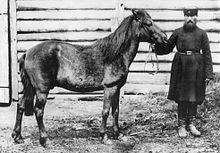
Back Equus ferus AN تاربان Arabic Okol (Equus caballus ferus) AVK Tarpan Azerbaijani Тарпан Byelorussian Тарпан BE-X-OLD Тарпан Bulgarian Tarpan BS Tarpan Catalan Tarpan Czech
| Tarpan Temporal range:
| |
|---|---|

| |
| The "Cherson tarpan", the only tarpan to be photographed, 1884 | |
| Scientific classification | |
| Domain: | Eukaryota |
| Kingdom: | Animalia |
| Phylum: | Chordata |
| Class: | Mammalia |
| Order: | Perissodactyla |
| Family: | Equidae |
| Genus: | Equus |
| Species: | |
| Subspecies: | †E. f. ferus
|
| Trinomial name | |
| †Equus ferus ferus Boddaert, 1785
| |
| Synonyms | |
| |
The tarpan (Equus ferus ferus) was a free-ranging horse population of the Eurasian steppe from the 18th to the 20th century.[1] What qualifies as a tarpan is subject to confusion. It is unknown whether those horses represented genuine wild horses, feral domestic horses or hybrids.[1][2] The last individual believed to be a tarpan died in captivity in the Russian Empire in 1909.[3]
Beginning in the 1930s, several attempts were made to develop horses that looked like tarpans through selective breeding, called "breeding back" by advocates. The breeds that resulted included the Heck horse, the Hegardt or Stroebel's horse, and a derivation of the Konik breed, all of which have a primitive appearance, particularly in having the grullo coat colour. Some of these horses are now commercially promoted as "tarpans", although such animals are only domestic breeds and not the wild animal themselves.
- ^ a b Cite error: The named reference
DPKwas invoked but never defined (see the help page). - ^ Lovász, Lilla; Fages, Antoine; Amrhein, Valentin (December 2021). "Konik, Tarpan, European wild horse: An origin story with conservation implications". Global Ecology and Conservation. 32: e01911. doi:10.1016/j.gecco.2021.e01911.
- ^ Cite error: The named reference
Bunzelwas invoked but never defined (see the help page).
